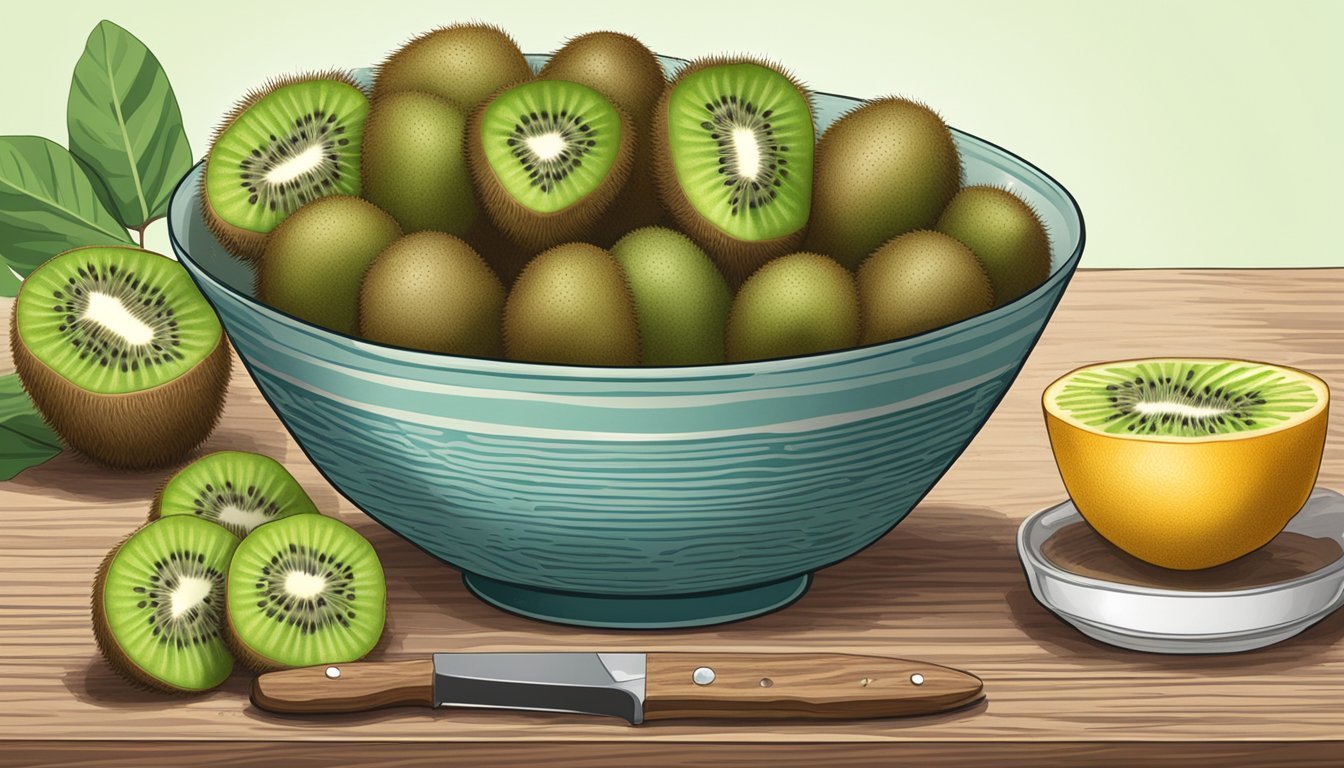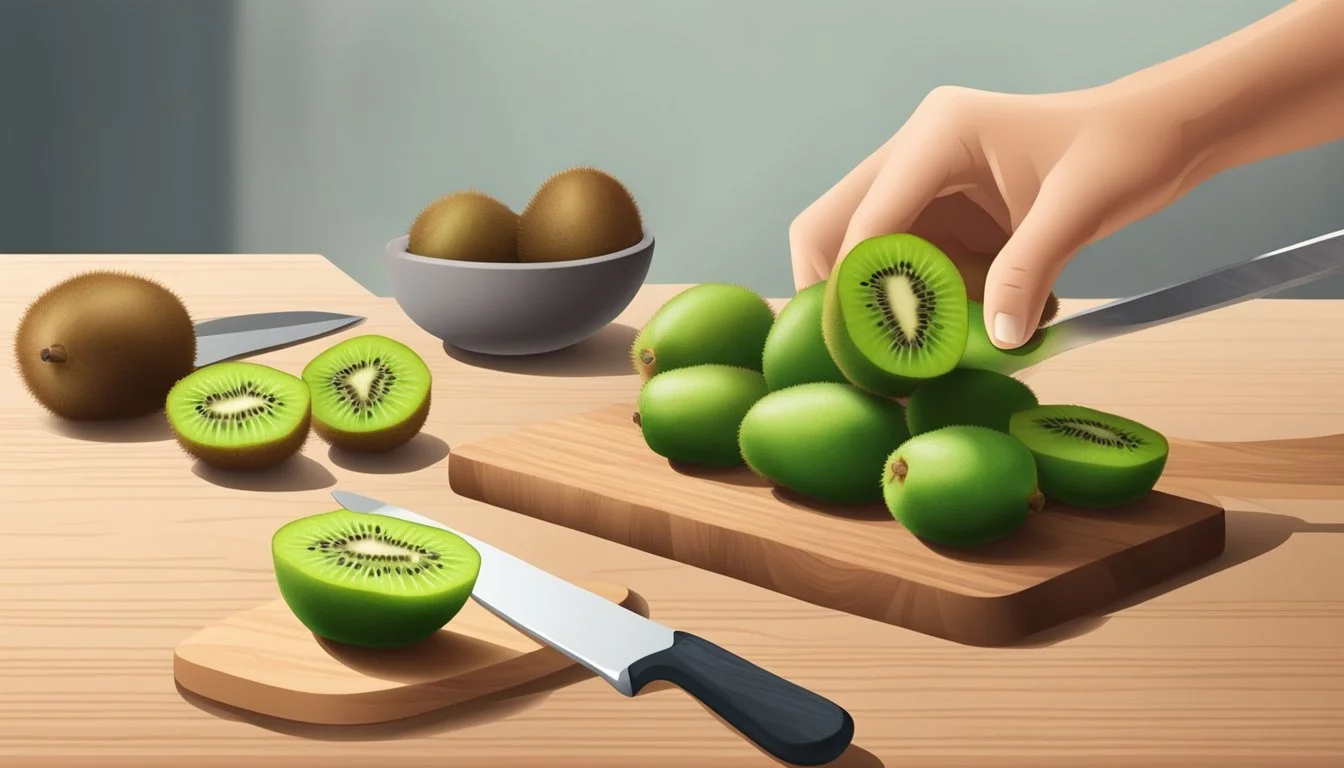How to Substitute Kiwi Berries for Kiwi Fruit
Easy Swap Guide
Substituting kiwi berries for kiwi fruit in recipes can be an excellent way to introduce a new texture and slightly different flavor profile to a dish. Kiwi berries, the miniature, grape-sized relatives of the familiar kiwi fruit (What wine goes well with fruit?), offer a sweeter taste and can be used without peeling, making them a convenient alternative. They are particularly well-suited for snacking, salads, or as garnishes due to their small size and delicate skin.
When replacing kiwi fruit with kiwi berries in recipes, consideration must be given to the size and quantity differences. Kiwi berries are much smaller than kiwi fruit, so it often takes a larger number of kiwi berries to match the volume and impact of a single kiwi fruit in recipes. Their sweetness might also require adjustments to sugar levels in desserts and other sweet dishes to maintain the desired taste balance.
Both kiwi berries and kiwi fruit are rich in vitamin C and dietary fiber, making them not only a tasty addition to meals but also a healthful one. They can both be used in similar ways in various culinary applications, from topping yogurt or cereal to being mixed into smoothies. The best substitutions account for the textural differences and sweetness levels to ensure that the final dish retains its intended appeal.
Understanding Kiwi Berries and Kiwi Fruit
The section elucidates the distinctions and similarities between kiwi berries and kiwi fruit, from their origins to their culinary applications and nutritional value.
Origins and Characteristics
Kiwi berries are native to northern China and were introduced to New Zealand in the 20th century. They resemble a small grape-sized version of the fuzzy kiwi fruit and share a similar emerald green interior dotted with black seeds. Unlike kiwi fruit, the kiwi berries' skin is smooth and can be eaten, negating the need for peeling.
Nutritional Profiles
Kiwi berries and kiwi fruit are both packed with vitamin C, important for immune system function, and fiber, which aids in digestion. They are both considered nutritional powerhouses, containing vitamins, minerals, magnesium, potassium, and antioxidants like vitamin E that contribute to overall health. In addition, they are low in fat, cholesterol, and sodium, which helps maintain good cholesterol levels.
Culinary Uses
Both kiwi berries and kiwi fruit are versatile in the kitchen. They can be enjoyed fresh or used as a garnish, in fruit salads, and even in salsas. While kiwi berries are ideal as a snack due to their size, kiwi can be sliced and added to recipes or used to create a decorative garnish due to its larger size.
Physical Attributes
The texture of kiwi berries and kiwi fruit is quite similar; they both have a soft, juicy interior filled with small, black seeds. However, the kiwi fruit is characterized by its fuzzy exterior, while kiwi berries boast an edible skin that is smooth and green.
Flavor Comparisons
Taste-wise, kiwi berries are sweet and tart like kiwi fruit but may also have notes of other fruits such as strawberry or pineapple. They are less acidic than kiwi fruit and sometimes can be sweeter, which may require adding less sugar when substituting in recipes.
Storage and Shelf Life
Kiwi berries have a notably short shelf life and are more sensitive to temperature changes than kiwi fruit. For optimal storage, keep them in the fridge to slow down the ripening process. Kiwi fruit also benefits from refrigeration but can be kept at room temperature for a few days if not fully ripe.
Rarity and Availability
While kiwi fruit is commonly available in most grocery stores across the United States, kiwi berries are considered more exotic and have a much more limited season, typically sold in September and October. They can sometimes be found in specialty stores like Trader Joe's but are not as widespread as their larger counterpart.
How to Substitute Kiwi Berries for Kiwi Fruit
Incorporating kiwi berries in place of kiwi fruit can invigorate recipes with a similar sweet and tart profile, while offering a unique texture and taste experience.
General Substitution Guidelines
Kiwi berries, the bite-sized relative of the traditional kiwi, can replace kiwi fruit in most dishes. Due to their small size, edible skin, and sweet flavor, they make an excellent substitute in recipes where kiwi's unique taste is desired but not its larger, fibrous texture.
Adjusting for Texture and Taste
Texture: Unlike kiwi fruit, kiwi berries have smooth, leathery skin that is edible, eliminating the need for peeling. Their seeds are also less prominent, providing a more uniform texture contrast in dishes like fruit salsas and salads.
Taste: Kiwi berries share the sweet and tart taste of kiwi fruit, but they can often be sweeter. When substituting, consider reducing additional sweeteners in the recipe to balance the flavor.
Quantities and Ratios
For most recipes, use a one-to-one volume ratio when substituting kiwi berries for kiwi fruit. Because kiwi berries are much smaller than kiwi fruits, you might need more kiwi berries to match the volume.
Kiwi Fruit Size Kiwi Berry Equivalent 1 large kiwi Approximately 5-8 kiwi berries 1 cup sliced kiwi Approximately 1 cup whole kiwi berries
Recipes and Preparation Techniques
Kiwi berries are versatile and can be used in an array of preparations:
Salads: Chop and mix into fruit salads.
Garnish: Use whole as an eye-catching garnish.
Smoothies: Blend whole into smoothies without the need for peeling.
Baked Goods: Incorporate into tarts, cheesecakes, or even atop pizzas for a sweet accent.
Tips for Peeling and Cutting
Peeling: Kiwi berries do not require peeling due to their edible skin, simplifying preparation.
Cutting: For recipes needing uniform pieces, kiwi berries should be halved or quartered, taking care to maintain the integrity of the seeds and the juicy interior.
Incorporating Kiwi Berries into Diet
Kiwi berries, a bite-sized relative of the kiwi fruit, pack a nutritional punch and offer a sweet and tangy flavor that enhances both sweet and savory dishes. Their versatility and health benefits make them an excellent choice for diverse culinary uses.
Health Benefits
Kiwi berries are a powerhouse of nutrients, including vitamin C, vitamin E, fiber, and various antioxidants. They contribute to heart health and skin health, while being naturally low in fat, cholesterol, and sodium. Their rich mineral content supports overall well-being.
Vitamin C: Essential for immune system support
Vitamin E: Contributes to skin health and acts as an antioxidant
Fiber: Aids in digestion
Antioxidants: Help to combat oxidative stress
Kiwi Berries in Sweet and Savory Dishes
Kiwi berries lend a sweet flavor to both sweet and savory creations. They are excellent in:
Fruit Salads: Their tangy taste complements other fruits.
Salsa: They can be the star in a vibrant, fruit-based salsa.
Tarts and Cheesecakes: Their small size makes them ideal for garnishing desserts.
Pizzas: Adding kiwi berries to a pizza offers a unique, sweet twist.
Creative Ideas for Snacking and Garnishing
For snacking, kiwi berries are perfect as they come—no peeling needed. They can also be used as a garnish to add a pop of color and flavor to a variety of dishes.
Yogurt Parfaits: Layer with granola and yogurt for a nutritious snack.
Cheese Boards: Pair with cheeses for a delightful contrast in flavors.
Frequently Asked Questions
Q: Can kiwi berries be eaten whole?
A: Yes, they can be eaten whole, skin included.
Q: How do you know when kiwi berries are ripe?
A: They should be firm but give slightly to pressure, similar to a ripe grape.
Maintaining Quality and Taste
To retain the quality and taste of kiwi berries when substituting them for kiwi fruit, proper storage and handling are critical. These methods ensure the berries' freshness is preserved from the moment they’re stored until they’re ready for use.
Best Practices for Storage
Kiwi berries have a short shelf life and are delicate, requiring careful storage to extend their freshness. The optimal storage method is to:
Refrigerate them at a low temperature, ideally in the coldest part of the refrigerator.
Avoid storing them near ethylene-producing fruits, as this can hasten ripening.
Techniques to Preserve Freshness
Maintaining the freshness of kiwi berries involves managing their exposure to the elements:
Before storing, wash the berries gently, and ensure they are completely dry to prevent mold growth.
For longer-term storage, freezing is an effective option. Spread the berries on a parchment-lined baking sheet, freeze them, then transfer to an airtight container.
Preventing Waste
Kiwi berries’ propensity to spoil quickly necessitates strategies to prevent waste:
Monitor their condition regularly to use any berries that are ripening faster than others.
Consider coating with sugar, lemon juice, or lime juice before freezing to provide an extra barrier against freezer burn and to retain their flavor profile.
Alternative Fruits and Additional Substitutes
When seeking alternatives for kiwi fruit, it's crucial to consider texture, flavor, and appearance. Several fruits can closely replicate the experience of kiwi, including options from within the kiwi family, exotic substitutes, and local seasonal fruits.
Close Substitutes Within the Kiwi Family
Golden Kiwi: A sweeter and less acidic cousin to the common kiwi, golden kiwis provide a similar texture with a tropical twist. They can be found in many supermarkets and are a straightforward substitute.
Kiwi Berries (Actinidia Arguta): These are mini versions of the kiwifruit, often grown in colder regions like Korea and Siberia. Their smooth, edible skin and sweet flavor make them an ideal replacement, especially in their peak season.
Exotic and Rare Substitutes
Dragon Fruit: With its unique appearance and seed-speckled flesh, dragon fruit can serve as an aesthetic and textural kiwi substitute. However, its flavor is milder and less tart.
Feijoas: Also known as pineapple guavas, feijoas offer a flavor that combines pineapple, guava, and kiwi. They are an exotic choice and may be found at specialty stores or international markets.
Sapodilla Fruit: Less known but worth considering, sapodilla fruits can replicate the sweetness of kiwi. Those seeking a similar sugary profile in their dishes might appreciate sapodilla as an option.
Seasonal and Regional Options
Local markets in the United States often stock a variety of seasonal fruits that can replace kiwi. Availability may vary, but these options can provide freshness and support local agriculture:
Summer: Look for ripe, sweet peaches and nectarines, which can mimic the juicy bite of kiwi.
Winter: Persimmons, available in some regions, offer a sweet, slightly tangy flavor that resonates with kiwi's essence.
Stores like Trader Joe's can be a good source for finding some of these alternatives, depending on the time of year and store location. It's always best to check with local produce suppliers for the most current and freshest options.






